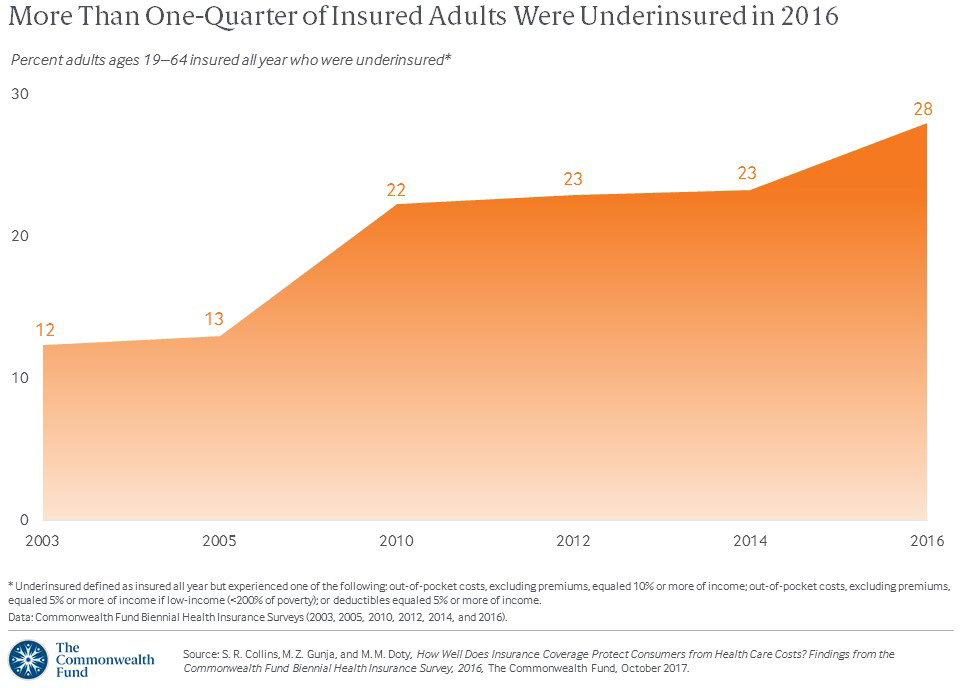New York, NY, October 18, 2017 — Twenty-eight percent of working-age adults in the United States who had health insurance all year were underinsured in 2016, up from 23 percent in 2014, according to a new Commonwealth Fund report. More than half of the underinsured (52%) had medical bill problems and 45 percent went without needed health care because of cost.
People who are underinsured have high deductibles and high out-of-pocket expenses relative to their income. For lower-income families, this means spending 5 percent or more of income on health care, while for higher-income families it means spending 10 percent or more. While the Affordable Care Act has led to historic gains in coverage, with 20 million fewer people uninsured since the law’s passage, health care costs and premiums continue to rise faster than wages. As a result, employers are requiring workers to share a larger proportion of these costs, especially in the form of higher plan deductibles. More than half (56%) of the estimated 41 million adults who are underinsured get their coverage through an employer.
How Well Does Insurance Coverage Protect Consumers from Health Care Costs?, which is based on findings from the Commonwealth Fund 2016 Biennial Health Insurance Survey, finds that people with all types of health insurance can be underinsured:
- About one-quarter (24%) of people with employer plans and more than two of five (44%) with individual or marketplace plans were underinsured in 2016, as were nearly half (47%) of disabled Medicare beneficiaries under age 65.
- People with low incomes were the most likely to lack adequate cost protections; they account for 61 percent of the 41 million underinsured. More than one-third of people who are sick and have high health care costs are underinsured as well.
- Workers in companies with 100 or more employees saw one of the sharpest increases in the underinsured rate. Twenty-two percent of workers in large firms are now underinsured, up from 8 percent in 2003.

“The growing number of people who are underinsured is concerning, especially because people with the greatest need for affordable health care are most likely to be affected — people with low incomes and people with health problems,” said Sara Collins, Vice President for Health Care Coverage and Access at The Commonwealth Fund and the study’s lead author. “People who are underinsured face problems affording health care at rates similar to those seen for people with no health insurance at all, and they are almost as likely to skip needed care and to end up in debt when they get sick.”
People Are Underinsured Because of High Deductibles and Out-of-Pocket Costs
According to the Commonwealth Fund report, underinsurance has risen in part because more people have deductibles, and because deductibles are higher. Specifically, it finds that:
- Twenty-three percent of adults with individual and marketplace plans had plan deductibles equaling 5 percent or more of income. Thirteen percent of people in employer plans had deductibles this high.
- In 2003, 40 percent of privately insured adults (employer or individual market coverage) had no deductible; in 2016 only 22 percent had no deductible.
- Only 1 percent of those with private coverage had a deductible of $3,000 or more in 2003; by 2016 that share had grown to 13 percent.
- High deductibles are associated with higher medical debt. Among adults with private coverage who had been insured all year, two of five (40%) with a deductible of $3,000 or more said they had difficulty paying their medical bills or had accumulated medical debt, compared with 21 percent of those who did not have a deductible.
What Can Be Done for Consumers?
Several policy options could help make health care more affordable for consumers, the Commonwealth Fund report finds. These include: extending the Affordable Care Act’s cost-sharing reductions to more enrollees, excluding more services from plan deductibles in both marketplace and employer plans, and increasing the required minimum value of employer plans. The authors note that, in addition to these options, policymakers must address rising health care costs.
“As we move beyond efforts to repeal and replace the Affordable Care Act, it is important to remember that many people, even some with insurance through their employers, still need better access to high-quality, affordable health care,” said Commonwealth Fund President David Blumenthal, M.D. “There are several bipartisan policy fixes that could make a huge difference for people struggling to afford the health care they need, while also making our health system work better for everyone.”
Additional Survey Findings
- About half (47%) of underinsured adults who had problems paying medical bills or had medical debt said they had used up all their savings to pay their bills. Forty percent said they had received a lower credit rating because of their bills.
- Underinsured rates for the nation’s four largest states varied. Adults in Florida and Texas were underinsured at higher rates than those in California and New York. Among adults had coverage all year, 32 percent of Floridians and 33 percent of Texans were underinsured, compared with 21 percent of Californians and 21 percent of New Yorkers.


